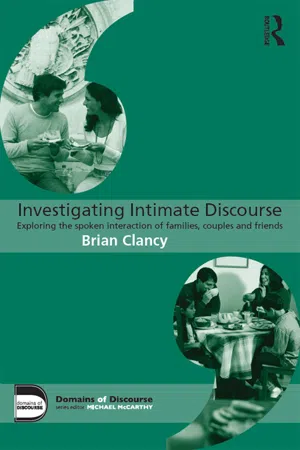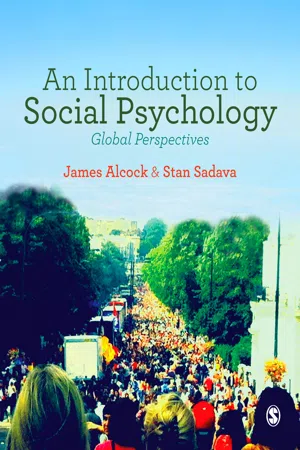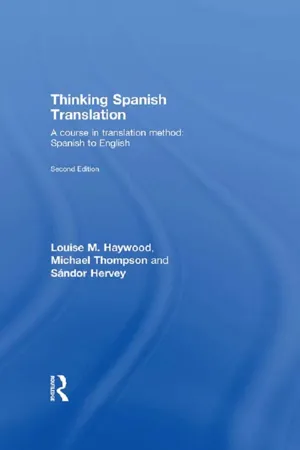Languages & Linguistics
Intimate Register
The intimate register refers to a style of language use that is characterized by familiarity, closeness, and emotional connection between speakers. It often involves the use of informal vocabulary, personal pronouns, and expressions of affection or endearment. This register is typically used in private or personal interactions, such as between close friends, family members, or romantic partners.
Written by Perlego with AI-assistance
Related key terms
5 Key excerpts on "Intimate Register"
- eBook - ePub
The Routledge Course in Translation Annotation
Arabic-English-Arabic
- Ali Almanna(Author)
- 2016(Publication Date)
- Routledge(Publisher)
Annotating registerIn this chapter …
The previous chapter has discussed how to annotate issues such as cohesive devices, thematic progression and parallelism. In this chapter, special attention will be paid to the field, mode and tenor of discourse. Further, issues such as formality, informality, personalization, impersonality, accessibility, inaccessibility, social status and standing will be given full consideration. To this end, ample authentic data drawn from existing translations or translated for the purposes of this study will be used to drive home relevant theoretical constructs.Key issues
- Accessibility versus inaccessibility
- Field of discourse
- Formality versus informality
- Mode of discourse
- Personalization versus impersonalization
- Register
- Social distance
- Standing
- Tenor of discourse
- Transitivity
The term ‘register’ was first used by the linguist Thomas Bertram Reid in 1956. However, it was introduced to the linguistic studies in the 1960s by a group of linguists who tried their hand at distinguishing among user-based variations and use-based variations. In linguistics, register is defined as a variety of a language used for a particular purpose or in a particular social setting (cf. Halliday 1964; Halliday and Hasan 1976; Zwicky and Zwicky 1982; Gregory 1988, among others). In a formal setting, for example when communicating with other people, an English native speaker may well opt for formal lexical items (such as ‘father’ instead of ‘dad’ ), formal syntactic structures and so on. The term ‘register’ is “used in so many different ways that it can be positively misleading” (Dickins et al. 2002: 162). Halliday (1978: 23) defines register as “the set of meanings, the configuration of semantic patterns, that are typically drawn upon under the specific conditions, along with the words and structures that are used in the realization of these meanings”. To cast it in less technical terms, register can be defined as a semantic configuration that is associated with a particular situation type and characterized on the basis of three variables: ‘field’, ‘tenor’ and ‘mode’. Although register analysis characterization in translation-oriented analysis cannot account for all contextual factors, it “still emerges as a powerful analytical tool and a necessary one, too, for communicative acts hinge upon the context of situation in which they occur” (Borrillo 2000: 1). In this regard, Borrillo (Ibid.) is of a view that register characterization plays a relevant part in the translation-oriented analysis of texts, as “it offers an initial interpretative hypothesis which then has to be substantiated against the textual evidence provided by linguistic structures and refined or modified by reference to the broader context of culture”. In register analysis, special attention needs to be paid to the three variables – ‘field’, ‘tenor’ and ‘mode’ - eBook - ePub
Investigating Intimate Discourse
Exploring the spoken interaction of families, couples and friends
- Brian Clancy(Author)
- 2015(Publication Date)
- Routledge(Publisher)
1992 : 13) who points out that our immediate concerns in the intimate sphere such as cooking dinner, putting children to bed or assembling the ubiquitous ‘flat pack’ have been dismissed as ‘irrelevant to the business of life’. In addition, the fact that intimate discourse is so familiar to us all means opinions about it may be readily proffered and yet rarely informed or supported and certainly not with any consideration of systematic corpus evidence from the context-type itself. Therefore, the aim of this book is to take an empirical approach to the linguistic patterns that characterise the plethora of speaker relationships and groupings that populate the intimate corner of the arguably ‘casual’, but certainly not ‘mundane’ or ‘banal’, spoken interaction.We begin with a consideration of what it means to be linguistically intimate. There are a number of issues to be considered here in relation to a definition of intimacy; for example, how we linguistically represent that our relationships are intimate with one person but not with another or whether or not we decide for ourselves who our intimates are or whether these decisions are made for us. Our attention first turns to issues such as these and how they have been represented in the previous literature. We then take our first look at how a corpus methodology might help to shed light on our interactions with our closest conversational companions.1.1 Characterising intimate discourse: Definitions and descriptions
Intimate interaction takes place ‘backstage’, a dramaturgical metaphor Goffman (1959) employed to invoke an area where conversational participants are relaxed, informal and off-guard. This area is, according to Goffman (1959 - eBook - ePub
- Gerard Van Herk(Author)
- 2012(Publication Date)
- Wiley-Blackwell(Publisher)
response . All utterances (from a greeting to a textbook) are addressed to somebody, and language results from a “reciprocal relationship between speaker and listener, addresser and addressee” (Voloshinov 1973/1929). People respond to others and expect a response in return: “I try to act in accordance with the response I anticipate” (Bakhtin 1986: 95).Genre, Register, Jargon- Languages involve heteroglossia , sometimes translated as “double voicing.” Any language at any point is massively internally diverse, full of jargons and dialects, which act to flavor all components of the language: “there are no ‘neutral’ words and forms – words and forms that can belong to ‘no one’; language has been completely taken over, shot through with intentions and accents … All words have the ‘taste’ of a profession, a genre, a tendency, a party, a particular work, a particular person, a generation, an age group, the day and hour. Each word tastes of the context and contexts in which is has lived its socially charged life; all words and forms are populated by intentions” (Bakhtin 1981: 293).
This last paragraph in particular seems to nail the issue of style and speaker identity performance. Every bit of language has social meaning derived from how it has been used and interpreted in the past, so whenever speakers make linguistic choices, they’re drawing on all those social meanings to create their own mashup, which they expect to trigger a social interpretation in their listeners.Style is a shifty thing – we’re always fine-tuning our output to our interlocutors and our purposes. But we also vary our language in ways that are not so split-second. The term register , like style, describes a type of speech, but it is more closely associated with a specific speech situation, often related to an occupation or particular pastime, so we can speak of a legal register or ritual language register or sports announcer register . People often speak of recipe register , although we can also think of recipe as a genre - eBook - ePub
An Introduction to Social Psychology
Global Perspectives
- James Alcock, Stan Sadava(Authors)
- 2014(Publication Date)
- SAGE Publications Ltd(Publisher)
Even within a particular combination of regional and social dialects, a given individual’s speech varies from situation to situation in terms of speech register (Romaine, 2000). Speech registers are varieties of a language that are used in particular situations. They reflect one’s emotional state, and we can quickly judge whether a person is angry or happy or unfriendly just by listening to a tape recording of the voice. Choice of speech register also reflects the relationship between the individuals who are conversing, as well as factors such as the speaker’s perceived relative status, and the speaker’s judgement about the listener’s own typical speech register. Do you speak any differently to your mechanic than you would to your physician or professor? Our choice of register can tell people a great deal about how we view them. Speech registers also vary with the context: Think of a professor intoning a lecture with authority and eloquence. If you were to overhear that same person speaking in the same manner to a companion over dinner in a restaurant, he or she would likely strike you as pretentious and overbearing – all because the speech register is inappropriate in that setting. We adjust our speech to the situation, and as we go through our daily lives, we change registers frequently as we encounter a variety of situations. Because the use of certain speech registers reflects a speaker’s power relative to the listener, the choice of speech register can have debilitating effects. In some situations, this is because it reminds listeners of their relative lack of power and independence. For example, one speech register that we all are familiar with is what linguists refer to as baby talk or BT. This refers not to the way that babies speak but to the way that adults talk to two- to five-year-olds. It is recognizable by its high pitch and exaggerated intonations (Caporael, Lukaszewski & Culbertson, 1983), and it is a feature of all languages (Ferguson, 1977, 2011) - eBook - ePub
Thinking Spanish Translation
A Course in Translation Method: Spanish to English
- Louise Haywood, Michael Thompson, Sándor Hervey(Authors)
- 2013(Publication Date)
- Routledge(Publisher)
Chapter 4 and the degree to which a particular piece of discourse is planned or unplanned. Oral conversation tends to be associated with informality, familiarity and spontaneity, oral address with a greater degree of formality, decorum and preparation; most forms of written language are in general likely to be more formal and controlled than most forms of oral language. However, genre does not determine register. Some kinds of conversation (such as giving evidence in court) are tightly constrained and formalized, while some kinds of oral address (a stand-up comedy act, for example) deliberately aim for the ‘lowest’ register they can get away with, as well as giving prepared material an air of spontaneity. When written texts aim for a relatively informal or familiar social register, they often do so by incorporating the linguistic markers of oral genres. An obvious and easy way of doing this in English is simply to use contractions in imitation of spoken language: the phrase ‘because you're with your mates’ in the previous paragraph stands out as signalling a different social register from the text around it thanks to the choice of ‘you're’ instead of ‘you are’ (as well as the lexical choice of ‘mates’).For the translator, social register is therefore a crucial part of assessing what kind of language one is dealing with and how a ST is designed to be perceived by SL readers, and as a result planning effectively for how the TT is to be designed for its target audience. Where there are linguistic and cultural differences in the ways in which two languages mark register, the translator needs to be able to draw on extensive SL and TL resources in order to find effective forms of compensation. Since social register is generated by so many different linguistic resources and sometimes consists of very subtle nuances, it is difficult to pin it down specifically in one language, let alone make systematic comparisons between a SL and TL for translation purposes. Nevertheless, it is possible to identify some useful patterns of comparison between Spanish and English in this respect, for which we can refer back briefly to the analysis of grammatical differences set out in Chapter 7
Index pages curate the most relevant extracts from our library of academic textbooks. They’ve been created using an in-house natural language model (NLM), each adding context and meaning to key research topics.




